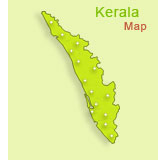¤¤ Kerala Vaasthu Vidya is not a religion but is a vidya, a science. Vastu only teaches us to follow the rules of nature and to balance the five elements from which we all, this universe is made up of. The system of Vastu is an admixture of science, astronomy of astrology; it is covered with the influence of the sun, moonlight and heat, the earth's atmosphere, wind direction, magnetic field and gravitation force on human beings. It gives practical guidelines on site selection, its contouring level, orientation of the building in relation to climatology and microweather, arrangements of areas/rooms in relation to the different activities of the proposed building. Their proportions as well as rituals for successive stages of house building.
The Vastu science is founded upon the laws of nature. The equilibrium we observe in the nature is easily perceivable by us in all moving bodies, but unfortunately we are unable to note this equilibrium in static bodies. The basic source of energy of the whole world is stored at North and South Pole. It flows uninterruptedly from North Pole to South Pole in the form of magnetic waves. Therefore Southward portion of every building should be higher than the northward portion so that there may not be any hindrance to the flow of magnetic waves.
It refers to an idea whose reign has come back to influence people's actions just as powerfully as it once did ages ago in ancient India. In recent times Vaasthu Shastra has become a new age fad. For the uninitiated Vaastu Shastra manipulates geography, topography and environment to channel positive energies and prevent imbalance. As a science, it incorporates principles of architecture, sculpture and
construction so as to capture all the positive effects of nature. Nature as we know, consists of five elements, viz, space, air, water and the earth. The ultimate aim of Vaastukala to use these recourses to construct a proper dwelling place that will determine the laws of peaceful co-existence .
As mentioned earlier, this science had evolved over the centuries, as a result of man's various trails to improve the slandered of living.This science date back from 6000 Bc to 3000 B. It was handed down to succeeding generations by word of month or through hand - written monographs. Keeping pace with the modern trends of development, the application of concept of Vaastu too, has changed. Vaastu has been laughed at, as another conman's bread maker, but it is a science, as it is systematic based on observation, facts and experiments. It can be considered rational, as it is based on the laws of nature and it pertains to the geological condition. It has shown itself to be practicable, has survived to the test of time, is universal utilitarian and governed by a set of principles. According to Vaasta, the entire universe exists in endless space, which has no such direction whatsoever. Our directions are defined with respect to the such,The four main primary cardinal directions are North, South, West, East. Apart from these are for intermediate spaces -north-cast, south-cast, north-west, and south-west.
According to this science all the eight directions have their own respective influences on the human beings. These directions and the angles they make have major implications on the people. East is known as the paternal side. So try and make sure that some vacant space is left on the east side, else it's believed that the male members shall die.
South east -begets health.
South brings happiness, peace and prosperity.
South west is responsible for attitude and behavior .
West brings progress and pride.
North west - the inter - relationship, range from friendship to hostility.
North - national side. If it's not kept vacant, it might spell death for the female members of the family.
North - east ensures continuity of lineage.
::Viswakarma Vaastu Shastra
It's considered to be an authorative text on Vaastu ,though the period of its development is still unknown. Apart from sculpture, it deals with the construction of building and religious architecture.
:: Bruhatsamhita
This treatise was presented in a simple and systematic manner and it was written by Varahamihira during the reign of the Guptas. It shows the differences in various types of buiulding ,measurement of floors and characteristics of the colors.
::
Vaastu Shastra
It was written by Sukhananda Yathi in the 12th century A.D
::
Vishnu Dharmottara purana
This dates back to the 7th century A.D and it deals with the basic principles of Vaastu, painting and sculpture.
::
Samarangana Suta Dharama
It was written by king bhoja in the 11th century A.D and deals with temple construction, idol fabrication, art and painting.
::
Pramans manjari
Was written by Sutradhara Miaallu in 12 A.D
::
Jaya pratchs
It is considered to be the oldest treatise on Vaastu in S.India covering the techniques of construction for residential ballistic purposes.
::
Shilpa Ratnam
This was inscribed on sculpture in 16 A.D
::
Vaastu Raja Vallabha
It was written by Mandana Sutradhari in 15 A.D
|






